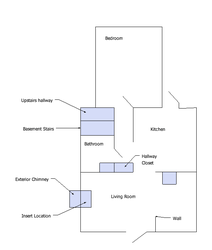Hello Everybody. This is my first time posting to this site even though I've been here for a lot of research over the past couple years. My wife and I own a 1250 square foot 1.5 cape. The foundation of the house dates back to the late 1800's although I think a lot of the structure has been updated throughout the years. I need to have some work done to the crown of our chimney and I'm thinking that now may be the time to get a fireplace insert.
I've attached a diagram of our layout. When we moved in the house leaked a lot of air so we had the crawl space and the rim board sealed with spray foam insulation. I've added 2x8's to the ceiling joists above our bedroom before we had additional dense pack blown in and we're now about R-40 over the bedroom (attic over the bedroom isn't heated) and R-40 in the attic over the main part of the house. About 1/2 the ceiling surface area on the second floor only has R-12 because of the 2x4 rafters (it's a cape so the second floor has part of the roofline as the ceiling). The flat section of our ceiling (small attic space) over the upstairs bedrooms also has r-40 insulation. Needless to say, the house is better but still leaks a lot. We went from a drafty barn to just a regular inefficient house.
I've been quoted $1200 to rebuild the crown of the chimney, $2300 for a Pacific Energy Super Insert or a Kodiak 1700 Enviro, $750 for a liner (includes insulating the top and bottom of the flue), $800 for labor and another $800 if I choose to have the whole liner insulated between the flue and the outside of the liner. Basically I can pay $1200 to have my fireplace fixed so it's not leaking H2O or I can pay $3500 (with the tax credit and not including the flue liner insulation) and have a new, safe flue, a new insert, lower heating bills, keep the warmth from going up my chimney and a non leaking fireplace.
If we go ahead with this project then I plan on cutting out two vents in the living room ceiling for heat to flow into the upstairs, another vent with a fan will go between the living room and the downstairs hallway wall to move heated air into the bedroom and up the upstairs hallway.
Can you critique this proposal? Specifically, I'm wondering:
1. Is it worth having the whole liner insulated
2. Are these inserts the best choices (manufacturers, sizes, burn rates)
3. Will the three vents be enough to move the heat and where could I buy a blast fan
4. Do the $ values seem correct
5. Would you advise putting a cold air return in the far end of the bedroom that would run in the basement back to the living room?
Thank you for being a great resource. I love the forum and I'm very happy to have such a knowledgeable group of minds to pull information from.
(The diagram only shows the first floor. The second floor is 1 bath and 2 bedrooms above the living room/kitchen/downstairs bathroom area)
I've attached a diagram of our layout. When we moved in the house leaked a lot of air so we had the crawl space and the rim board sealed with spray foam insulation. I've added 2x8's to the ceiling joists above our bedroom before we had additional dense pack blown in and we're now about R-40 over the bedroom (attic over the bedroom isn't heated) and R-40 in the attic over the main part of the house. About 1/2 the ceiling surface area on the second floor only has R-12 because of the 2x4 rafters (it's a cape so the second floor has part of the roofline as the ceiling). The flat section of our ceiling (small attic space) over the upstairs bedrooms also has r-40 insulation. Needless to say, the house is better but still leaks a lot. We went from a drafty barn to just a regular inefficient house.
I've been quoted $1200 to rebuild the crown of the chimney, $2300 for a Pacific Energy Super Insert or a Kodiak 1700 Enviro, $750 for a liner (includes insulating the top and bottom of the flue), $800 for labor and another $800 if I choose to have the whole liner insulated between the flue and the outside of the liner. Basically I can pay $1200 to have my fireplace fixed so it's not leaking H2O or I can pay $3500 (with the tax credit and not including the flue liner insulation) and have a new, safe flue, a new insert, lower heating bills, keep the warmth from going up my chimney and a non leaking fireplace.
If we go ahead with this project then I plan on cutting out two vents in the living room ceiling for heat to flow into the upstairs, another vent with a fan will go between the living room and the downstairs hallway wall to move heated air into the bedroom and up the upstairs hallway.
Can you critique this proposal? Specifically, I'm wondering:
1. Is it worth having the whole liner insulated
2. Are these inserts the best choices (manufacturers, sizes, burn rates)
3. Will the three vents be enough to move the heat and where could I buy a blast fan
4. Do the $ values seem correct
5. Would you advise putting a cold air return in the far end of the bedroom that would run in the basement back to the living room?
Thank you for being a great resource. I love the forum and I'm very happy to have such a knowledgeable group of minds to pull information from.
(The diagram only shows the first floor. The second floor is 1 bath and 2 bedrooms above the living room/kitchen/downstairs bathroom area)


